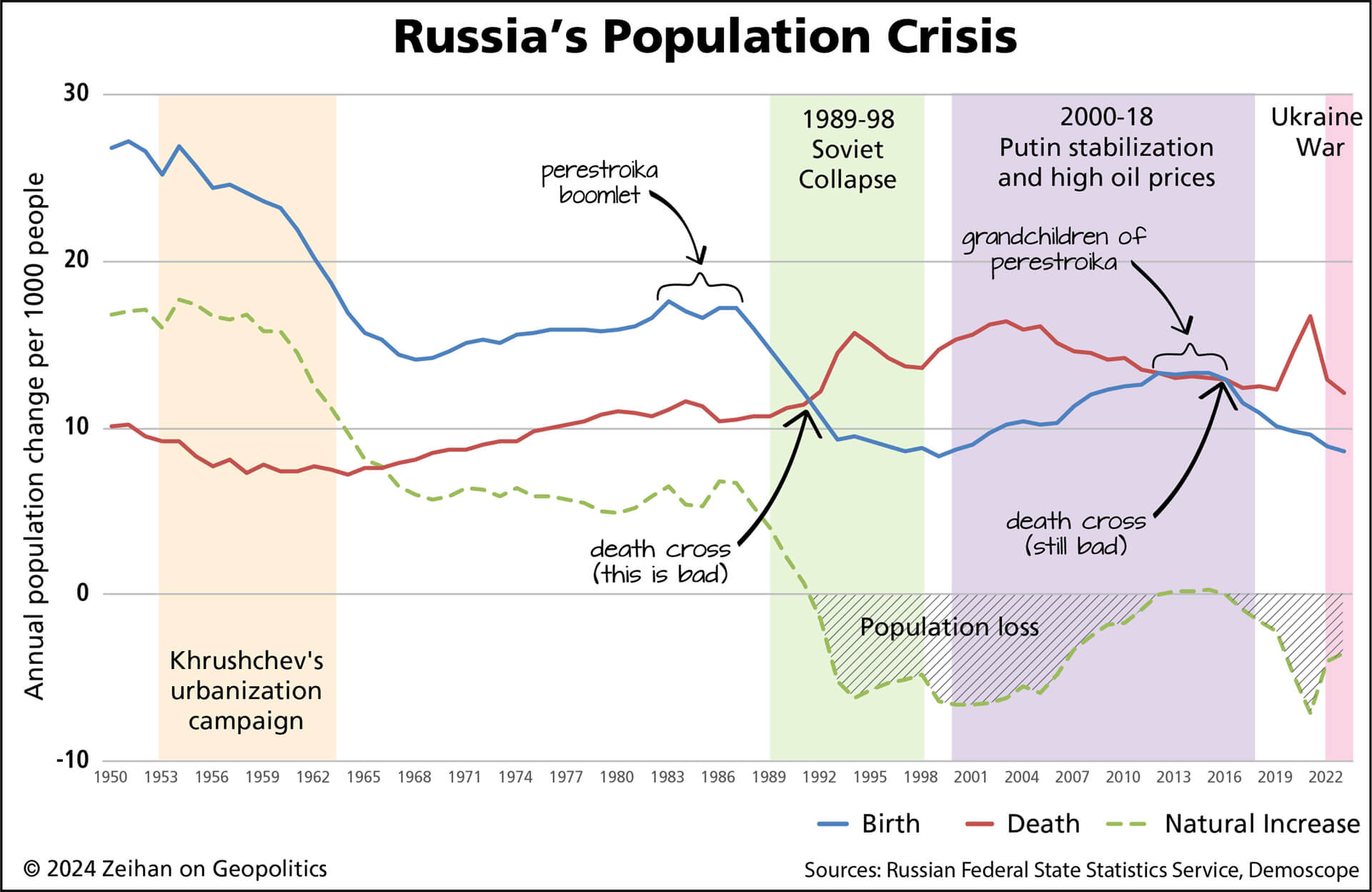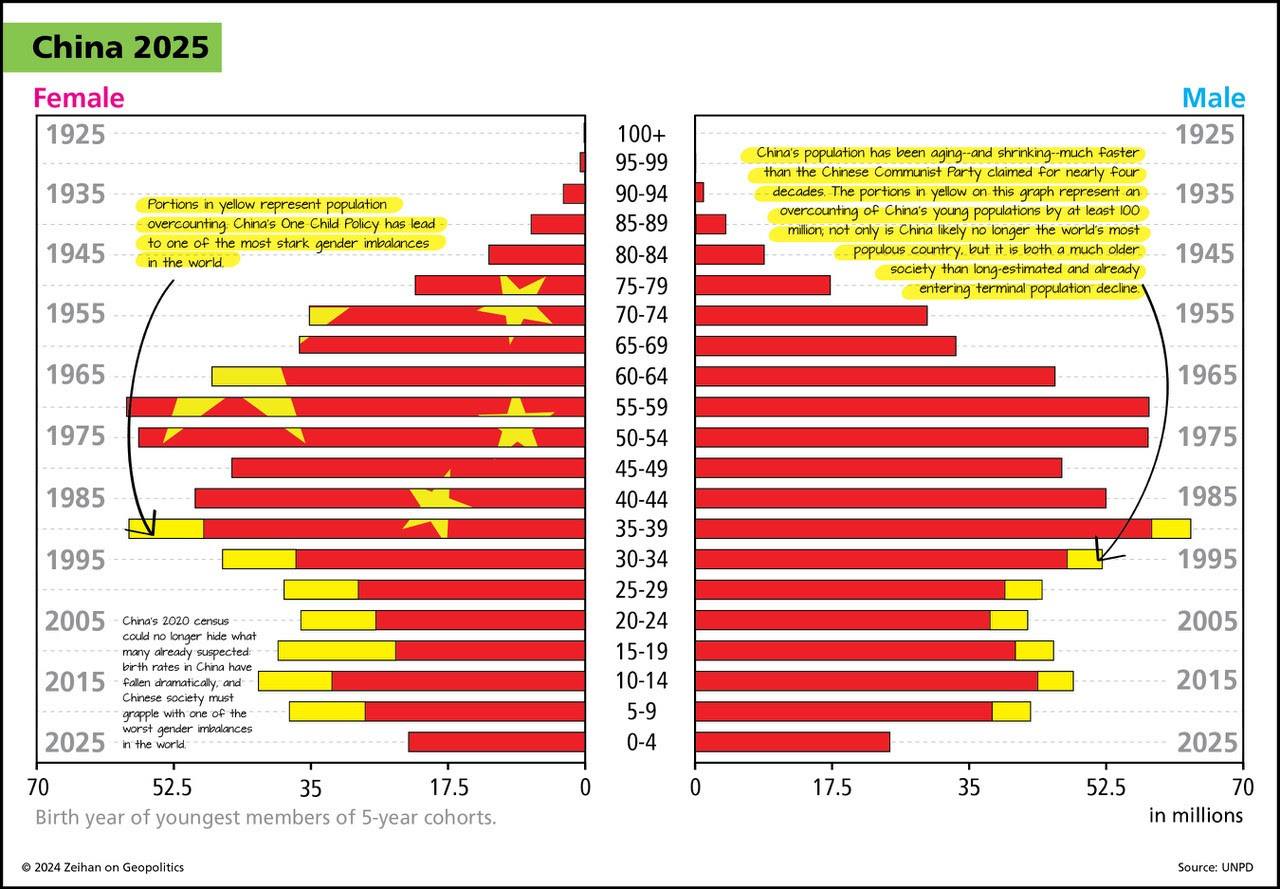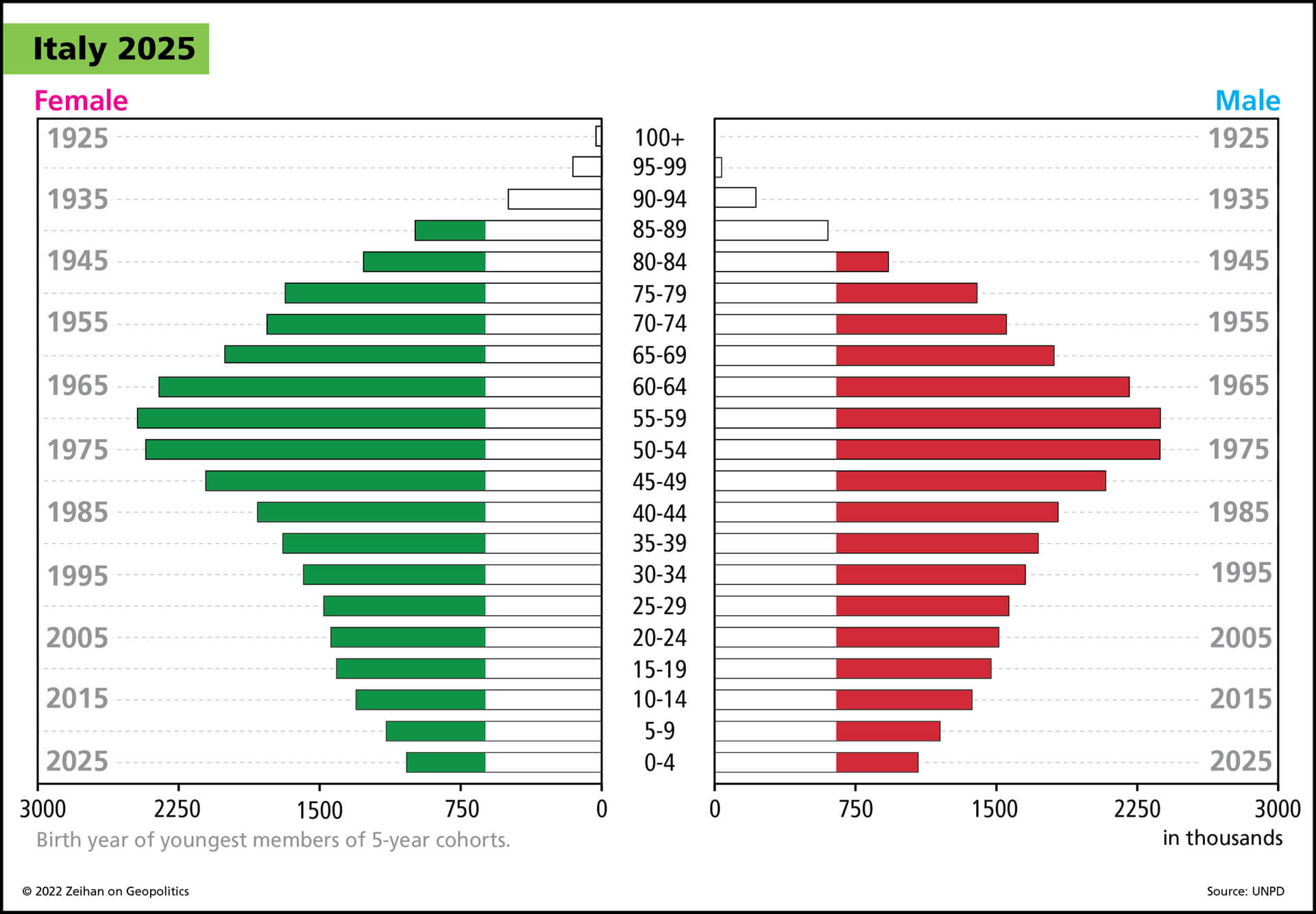The Russian demographic crisis is worsening. So, let’s look at the long-term structural, social, and economic problems, as well as some of the more recent changes hurting the Russian population.
Forced urbanization under Stalin and Khrushchev meant fewer children. Major wars led to dramatic population holes. Substance abuse, both drugs and alcohol, has raised deaths and lowered birth rates. Economic instability discourages family growth. High abortion rates, well that one is self-explanatory.
And now the Ukraine War has accelerated this demographic decline, especially amongst men under 30. Rather than addressing the root causes, the Russian government would rather push its propaganda; like a new law that bans any media that doesn’t promote childbearing. And of course we can’t get reliable data out of Russia, so things are worse than advertised.
Transcript
Good morning All, Peter Zeihan here coming to you from Zion National Park’s infamous West Rim Trail. Good morning. Today we’re going to look at something that’s happening in Russia with their demographic work. Before I give you the trigger, let’s give you the background. The demographic situation in Russia is bad and has been declining for the better part of a century.
Basically, there are three interlocking trends. First is that whenever any country urbanize or industrialize is, the birth rate drops because people move on from farms where kids are free labor to cities where they’re an expense. And you fast forward a couple of generations and the numbers just get worse and worse. In the case of Russia specifically, however, Stalin and Kristoff are the people who are responsible for the industrialization and the urbanization.
So people were forced into small apartments, that were efficiency or at most one room, which really, dissuaded having more kids. And you had collectivization, in the agricultural sector where people no longer could profit from the work that they did on the farm. And there just was no impetus for people to want to work. Therefore, there was no impetus for people to want to have children.
On top of that, you have these giant gouges out of the demographic structure of Russia from major events like, say, the world wars, where, you know, several million people were killed, and, or were away from their spouses for a long period of time, making the formation of families at all very, very difficult. Now, the second big issue is drugs and, alcoholism.
One of the first things that the Russians industrialize was the creation of vodka. And vodka still today, is, day to day plague. Beer is considered not an alcohol. You can actually get it in a lot of vending machines on your way to work if you want to, but hard drugs were the real problem.
When the Soviets went into Afghanistan, one of the things they discovered was heroin. Because the largest poppy fields in the world at that time were in, Afghanistan. And because there were now transport links between Afghanistan and the former Soviet Union. We saw three of the four major heroin smuggling routes in the world. Trans north through Russian positions and into Russia and into the rest of the world.
It’s a lot worse than it sounds, because even when the Soviets left Afghanistan, they left a buffer force behind in Tajikistan. Even after Austin got independence. And the soldiers there who were supposed to keep, keep the Taliban from interfacing with the rest of the former Soviet Union didn’t only fail. They then took a chunk out of the drug trade and actually facilitated its flows into Moscow.
So we had at some point something like 10 million heroin addicts in post-Soviet Russia, a country with under 150 million people, very, very bad for demographics, kept the death rate high, kept the birth rate low. And then third and most, finally, you have significant economic degradation. The Soviet Union was a superpower, but it never really was an economic superpower.
They never achieved the types of growth after about the 1960s that was necessary to advance a technological population. So we had long periods of stagnation under Brezhnev, and then we had the post-Soviet collapse and now the Ukraine economic contraction, all of which have convinced people that tomorrow is going to be worse economically for them today. And that is arguably the single worst thing for convincing people to have kids.
If you don’t think there’s going to be a world for them to live in, you usually don’t want to have them. And so Russia traditionally has the world’s largest and highest abortion rate as well, with some statistics suggesting as many as 70% of all pregnancies are terminated. On top of that, most recently we have the Ukraine war.
When the Russians started mobilizing, a million men aged 30 and under fled the country. And since the war began three years ago, a million men, mostly aged 30 and under, have either been killed or incapacitated to the point that they’re functionally non workers within the Russian system. So this is bad. It’s only going to get worse. And so the trigger what’s making me talk about this today is that there is a bill going through the Duma.
That’s the national parliament in Russia that would criminalize, the publication or the broadcasting of any media that does anything other than glorify the production of children. So if there is a character in the show that, for whatever reason, has chosen not to have kids and say, you, like, have a career that is now going to be illegal in Russia, and before you say, that’s going to have no end, in fact, keep in mind, this is Russia, in fact, and fiction are oftentimes intertwined.
Back during the 2000, there were several provinces in Russia that criminalized death. On Mondays, Wednesdays and Fridays. That’s how they were going to cut the death rate in half. And you know what? It worked because people just stopped reporting deaths. Which brings us to the final point here. Statistics in Russia, on a good day are kind of Potemkin.
And on this topic in particular, the Russians have not been collecting, much less analyzing, much producing any reasonable statistics on birth or death rates now for over 15 years. So we really don’t know what the real picture is. We can only guess now. When the Russians did their first post-Soviet census back in the 2000, the best guess is that the population of Russia proper was about 140 million.
The census found another 4 million people somewhere, and now they’ve said they’ve had 144, according to the official statistics. That has now been whittled down to 141. Ignoring the Ukraine war, ignoring the X migrations. In reality, we’re probably closer to 130, but there’s really no way to confirm that. All we know is that the clearest sign that the Russians are facing a real pressure in the demographics is going to be what happens with the Ukraine war, because if they simply run out of men who are under 30, who can fight that, it’s going to be very, very visible.
But we’re not there yet. They started the war with their own statistics by 8 million people in that block between X migrations and deaths and casualties. We’re now down to about 6 million. So they can keep this pace up for several more years. Just the question at the end of the day is of the younger generation, people 20 under how many were there ever?
And we have never had a good count of that number. But because of the war, we’re going to find out pretty soon.















